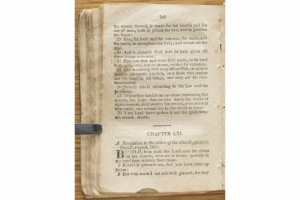Historical Context and Background of D&C 60
Brief Synopsis by Steven C. Harper
Having dedicated western Missouri as Zion and a spot near the courthouse in Independence as the site for the temple centered in New Jerusalem, Joseph Smith and his companions sought to know what the Lord would have them do next. The Lord answered with section 60, which John Whitmer described as a “COMMANDMENT given in Missorie Jackson County Independence August 8th 1831 directions to some of the Elders to return to their homes & own land.”1
The Lord tells the elders planning to return to Ohio quickly that he is pleased with their trek to Missouri, with the exception are those whose fears kept them from preaching the gospel. He is upset with them and says they will lose what he has given them if they do not offer it freely to others.
About the return trip to Ohio, the Lord tells the elders to get a boat that seems to them best suited for the purpose of heading down the Missouri River toward St. Louis. It doesn’t matter to him whether they make it or buy it, only that they do not waste time. Once in St. Louis, Joseph, Sidney Ridgon, and Oliver Cowdery are to head for Cincinnati to declare the gospel with faith, not anger.
Alluding to his Old Testament title “I Am,” a variation on the name rendered in English as Jehovah, the Lord commands them to “lift up holy hands upon them. For I am able to make you holy, and your sins are forgiven you” (D&C 60:7; cross reference Exodus 3:14 and D&C 68:6).
The remaining elders should leave St. Louis in companionships and thoroughly preach the gospel to those who have not yet repented until the elders arrive in Ohio. This will benefit the branches of the Church, which is why the Lord gave the command. Bishop Partridge should give them enough of the Lord’s money to fulfill their missions. Those who are able should pay the Lord back by giving the money to Sidney Gilbert, the bishop’s assistant.
The Lord also speaks about the elders who left Ohio for Missouri but have not arrived due to the missionary work in which they engaged on the way. He commands them: “Thou shalt not idle away thy time, neither shalt thou bury thy talent that it may not be known” (D&C 60:13). Once they arrive in Missouri, now Zion, and preach there, they should return to Ohio quickly, preaching along the way to those who have not repented. They should preach thoroughly, kindly, and without provoking the people.
Rather than condemning openly those who chose not to receive the gospel, as Parley Pratt did to the Believers at North Union, Ohio (see section 49), the elders are to signify that they have freely offered the gospel by washing their feet privately as a testimony, on judgment day, that they did not hide the good news from anyone. This act signifies that knowledge and therefore accountability have been transferred from the missionaries to the people.
Joseph and his companions obeyed section 60 and headed for home in Ohio as directed. On August 9 Joseph and ten other brethren headed down the Missouri River on canoes bound for St. Louis.2
1. “Revelation, 8 August 1831 [D&C 60],” p. 100, The Joseph Smith Papers, accessed September 5, 2020.
2. Times and Seasons 5 (March 15, 1844): 464. Reynolds Cahoon, Journal, Church History Library, Salt Lake City.
Additional Context by Casey Paul Griffiths
From Doctrine and Covenants Minute
With the land of Zion dedicated and the emigrants from the Church building their homes, it was time for the majority of the elders in Missouri to return home. Some elders, including Edward Partridge, would stay behind to assist the Saints in gathering and building the city. The Lord commanded most of the elders to return to Ohio and provided instructions for how to carry out the journey. In his history, Joseph Smith introduced the revelation by simply noting, “On the 8th, as there had been some inquiry among the elders, what they were to do, I received the following” (Joseph Smith—History, vol. A-1, 141, JSP).
See “Historical Introduction,” Revelation, 8 August 1831 [D&C 60]

